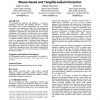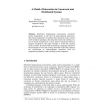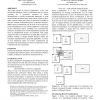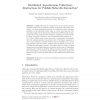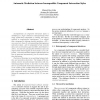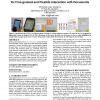ACMIDC
2009
14 years 12 months ago
2009
We investigate the similarities and differences
135
click to vote
ARES
1998
Springer
15 years 3 months ago
1998
Springer
Distributed programming environments commonly restrict programmers to one form of intercomponent interaction. This forces programmers to emulate other interaction styles in terms o...
CHI
1999
ACM
15 years 3 months ago
1999
ACM
This paper reports on Direct Combination, a new user interaction technique. Direct Combination may be viewed variously as: a systematic extension to Direct Manipulation; a concise...
ECOOP
2000
Springer
15 years 3 months ago
2000
Springer
ions for Publish/Subscribe Interaction Patrick Th. Eugster1 , Rachid Guerraoui1 , and Joe Sventek2 1 Swiss Federal Institute of Technology, Lausanne 2 Agilent Laboratories Scotland...
CHI
2000
ACM
15 years 3 months ago
2000
ACM
This article introduces a new interaction model called Instrumental Interaction that extends and generalizes the principles of direct manipulation. It covers existing interaction ...
77
Voted
DSVIS
2003
Springer
15 years 4 months ago
2003
Springer
Research has created many new generation (post-WIMP) Interaction styles (IS) in the past years. From Ubiquitous to Affective Computing, researchers have not kept a uniform standard...
79
Voted
HICSS
2003
IEEE
15 years 4 months ago
2003
IEEE
Incompatibility of component interaction styles is identified as a major obstacle to interoperability when using off-the-shelf components or dealing with legacy software in compos...
81
Voted
IUI
2006
ACM
15 years 4 months ago
2006
ACM
We explore the concept of interaction styles used to navigate through hypermedia systems. A demonstrator was built to conduct a user study with the objective of detecting whether ...
MM
2009
ACM
15 years 5 months ago
2009
ACM
Existing cameraphone-based interactive paper systems fall short of the flexibility of GUIs, partly due to their deficient fine-grained interactions, limited interaction styles and...
TEI
2009
ACM
15 years 5 months ago
2009
ACM
Tangible User Interfaces (TUIs) are commonly accepted as those in which the configuration of physical objects embodies digital system state, providing “graspable” digital medi...
